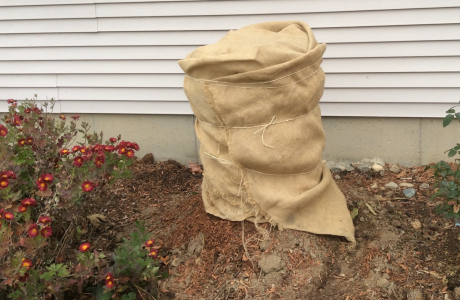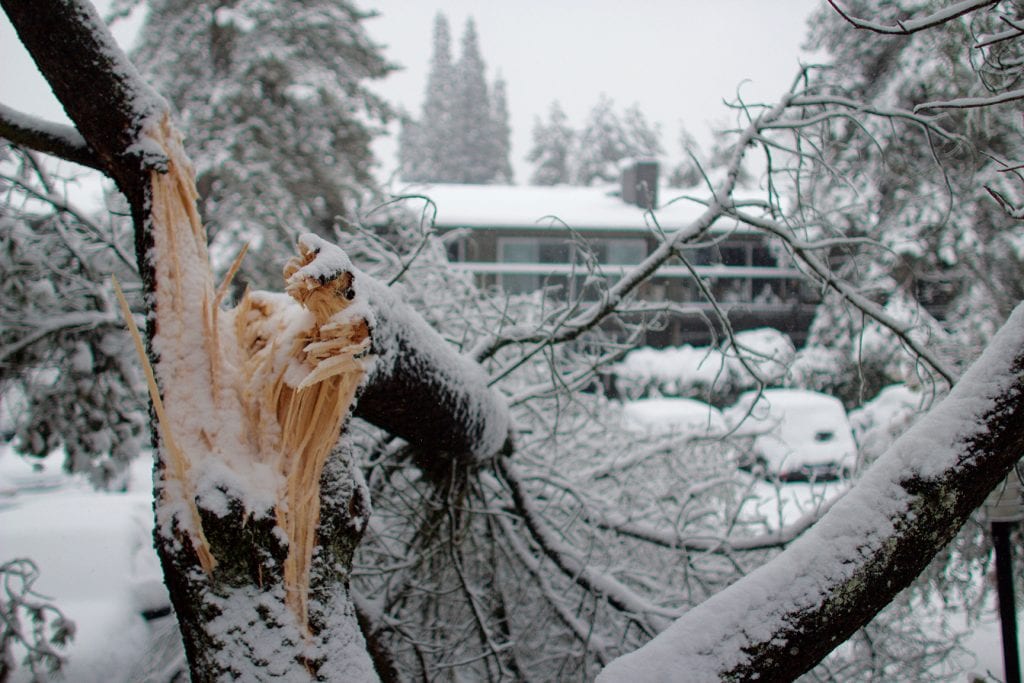
With the ice and snow damage fresh on our collective minds and the forecast showing the possibility of more freezing precipitation, it seems only fitting to discuss winter damage and how to protect trees and shrubs. Not only does snow and ice cause damage to trees, but so can cold temperatures and windburn which are not always identified properly. While it’s possible to protect some plants when it comes to large trees, damage can be inevitable, so it’s important to inspect trees following an ice event to make sure that damage has not caused structural issues that are soon hidden by spring foliage.
When ice or heavy snow is in the forecast, it’s good to prepare your small trees and shrubs by protecting them with supplementary support to keep them from bending and twisting in the snow. One of the most commonly damaged groups of plants is evergreen shrubs with multiple interior stems, such as Arborvitaes, Sky Pencil Hollies, and English Boxwoods. By temporarily wrapping the exterior of the plants with twine or even burlap, it’s possible to prevent any damage before the weather event begins. These wraps should always be taken off before spring growth so that it does not limit shoot or leaf expansion.

In some instances, with fragile plants, it makes sense to set up a wooden A-frame structure over plants that has horizontal cross boards that deflect any snow or ice from building up to damaging levels. These protective structures can be put up in the early winter and left up until spring, at which point they can be stored until the next winter.
It’s not always practical to preventatively protect your plants, at which point, it’s important to keep an eye on accumulations during the event so that snow and ice can be brushed or shaken off of the plants. When heavy wet snow builds up on shrubs, it has a tendency to spread out and bend the individual stems away from one another causing damage to the overall form of the plant and often bark damage as well. To prevent this, the plants should be gently shaken or brushed with a broom to knock excess snow loose. This often has to be done multiple times during a storm as it is much easier and less stressful on the plant to gently knock a small amount off rather than further stressing an already stressed branch or stem.
When heavy snow or ice is already built up on shrubs, any extra jostling can cause the stems to snap. With existing heavy buildup, it is often better to leave the snow and ice until the storm has stopped so that the limbs can flex a bit for later removal. Once snow is removed, it’s best to tie up and support any bent limbs as soon as possible to prevent more damage to the bark and underlying tissue when the stem is bent back into place. Leaving limbs and stems bent for extended periods of time will also increase the likelihood of stem damage or death as cracked open bark can allow desiccation before spring growth can close wounds.

Physical damage is not the only threat to plants during winter though it is quite often the most evident and thus easily identified. Cold damage occurs frequently in Central Virginia in the months of January, February, and March when temperatures drop into the teens and single digits. Most plants in the Richmond area can tolerate one to two very cold days without a problem, but extended periods of cold, dry weather can cause significant damage to many evergreens in the area. While cold temperatures can kill some above-ground growth on marginally hardy plants, it is actually the cold temperatures mixed with low humidity that does the most damage, called “winter burn.”
Water will frequently melt in the leaves and needles of evergreen plants from sun exposure even if air temperatures are below freezing. This liquid water can be quickly lost through the leaf cuticle when the humidity is very low causing desiccation and “burning” of the leaves and needles. This damage can be slow to develop and may even show up in the spring when the damaged leaves begin to brown and drop. While it’s impossible to alter the outside temperature, it is possible to limit water loss by wrapping and covering plants with burlap or similar textiles as it limits sunlight on the foliage and also reduces the drying effects of any wind. This protection does nothing to limit freeze damage on marginally hardy plants, but it can be very effective in limiting damage to evergreens.
The final important part of protecting your trees and shrubs is through a thorough inspection following any large snow or ice storm. Especially in ice storms, it’s likely that limbs will split or break without coming out of the tree canopy. This creates weak spots in the canopy, widow makers, and places for decay and infection to enter the plant. Finding damage early is much easier without new foliage on the plants and can prevent new leaves from weighing down an already compromised limb, causing a hazardous failure. Timely removal of damaged branches before spring will allow the tree to begin closing over the wound as soon as growth resumes for the season.
A little bit of time spent before an upcoming storm or even a bit of playing in the snow can help to protect your trees and shrubs from snow and ice damage, but no matter how hard you work, extreme cold is a problem that does not have a solution. If we are unlucky enough to have another visit from the dreaded Polar Vortex again this winter, wrapping plants can buy you several degrees of protection but usually not enough to prevent all damage. Good spring cleanup to remove dead tissue will improve the appearance of the plants and provide room for new healthy growth


